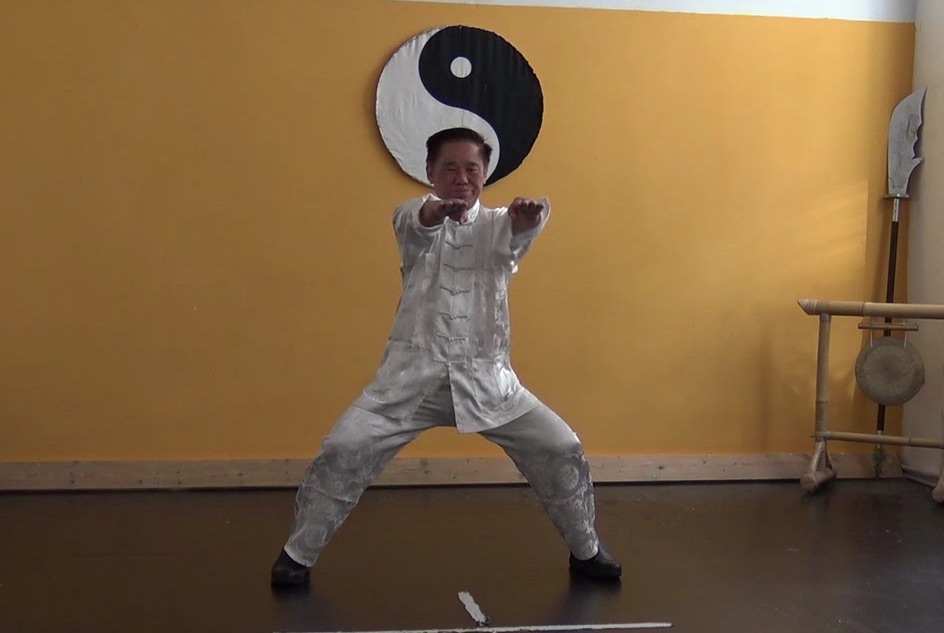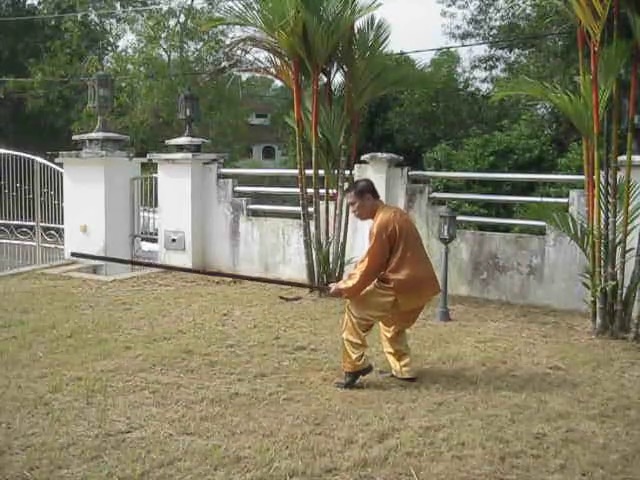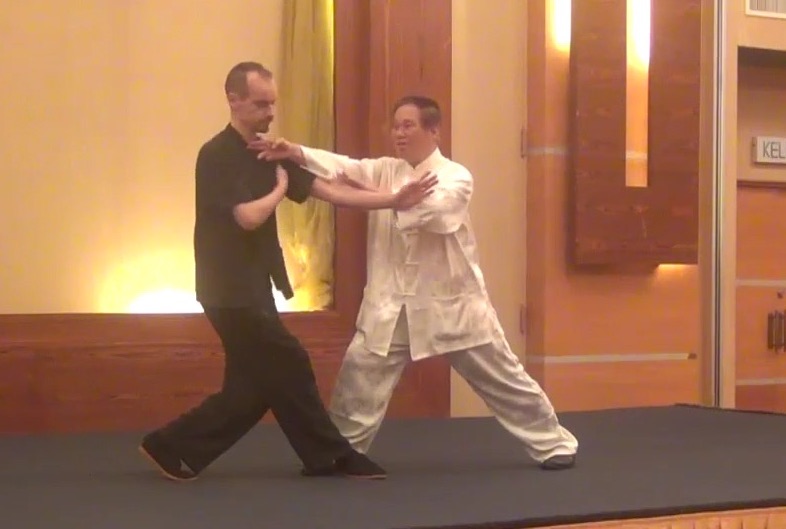SELECTION OF QUESTIONS AND ANSWERS
JULY 2019 PART 2

Grilled prawns of Lisbon
Question 1
What food do you find most delicious in the world?
— Ruben, Spain
Answer
Thanks to my students who take me to restaurants with delicious meals, I can enjoy the most delicious food in many parts of the world.
The food I find most delicious is Portuguese grilled prawns found in Lisbon. Some of my students have used the Portuguese grilled prawns as a yardstick to measure other types of food.
Other very delicious types of food are jarmon and fresh orange juice in Spain, grilled fish in Portugal, ice-cream and coffee in Italy, and dry curry beef in Malaysia.
I really consider myself luckier than an emperor in the past. An emperor could enjoy the best food in his empire, but I can enjoy the best food in the world.
Question 2
How do I incorporate the Dragon-Tiger Set into my regular practice?
— Monte, Switzerland
Answer
Obviously you do not just practice the routine of the Dragon-Tiger Set but also other aspects we learn in the course.
Let us take your training session to be half an hour per day, and you intend to follow the programme for a year. Previously I recommended one hour per session, but because of the improvement of our methodology, now half an hour is sufficient. If you practice for a longer or a shorter period, you can adjust accordingly. Of course, others may use other sets.
Start with the Dragon-Tiger Set for about 5 minutes. Use the four stages of practice we have learned, namely routine, form, force and flow. Initially ensure that your routine is correct. We have done that in the course, and you can also refer to the routine in our videos. This will take you about one week.
Next, focus on picture-perfect form. This may take you another three weeks or a month. For the remaining eleven months you focus and improve on your force and flow.
Remember that you should not just go over your routine with improved form. You check your form to make it picture-perfect. That means you may repeat each pattern many times, or perform only those patterns where your form is not picture-perfect. You should spend only about 5 minutes each day.
Then spend about 15 minutes for your 16 basic combat sequences (or 12 basic combat sequences in Taijiquan). You may not complete all the 16 combat sequences; you can practice them in rotation, like 3 combat sequences for each week, or in any way you like.
Practice them in four stages -- routine, form, force and flow, not all the four stages at once, unless you are advanced, in which case you focus on force and flow, but at whatever stage or stages you find suitable. Later you may also practice the 4 combat sequences of Dragon-Tiger Set.
Next you spend 5 minutes on "Double Dragons Emerge from Sea" to develop internal force and mental clarity. Again the four stages of routine, form, force and flow will be very useful. Or you may spend the 5 minutes on stance training.
Use the remaining 5 minutes to practice whatever you like, such as revising your previous material to be more skillful, or trying out new material.
When you have a plan, which includes your aims and objectives, you will find your practice purposeful and cost-effective.

Double Dragons Emerge from Sea of Dragon-Tiger Set
Question 3
Why in Flowing Water Staff and Six and Half Point Staff, the staff is held with left hand in front and the right hand supporting, but in Fifth Brother Pakua Staff it is reverse, right hand in front and the left hand supporting? I just wonder maybe Grandmaster Wong could give an explanation according to his deepest understanding of kungfu that Grandmaster has.
— Anshor, Indonesia
Answer
In both the Flowing Water Staff and the Six and Half Point Staff, where the left hand is in front and the right hand behind, the right hand is the controlling hand and the left hand the supportive hand.
In the Fifth Brother Pakua Staff, where the right hand is in front and the left hand behind, the right hand is also the controlling hand and the left hand the supportive hand.
In kungfu terminology, the controlling hand is called the "emperor's hand", and the supportive hand the "minister hand". The right hand in all the three staff sets is considered the "emperor hand" because it controls the staff.
The Flowing Water Staff and the Six and Half Point Staff are used like a spear. Hence the right hand, which is behind, is controlling. Imagine a staff master aiming at you with a pistol and shoots at you with the tip-end of the staff.
The Fifth Brother Pakua Staff is more like a staff where hitting with the upper shaft of the staff is performed. Staff sets from wushu are performed like a staff.
The right hand is the controlling hand because most people are right-handed. What about those who are left-handed? They will have an extra advantage that their right hand will be as adroit as their left hand after training with the staff set.
Question 4
I have a friend whose life is fitness in the Western sense of the word. He has recently undergone a spiritual awakening which shocked him mentally. He had to go to hospital but he's out now. I want to suggest qigong to him as a good practice for his spirituality as the benefits are amazing, not to mention also for health. I also find it great for his peace of mind but I know from your teaching that weight lifting and running does not go with qigong. Do you have any advice on what I can recommend to him? I don't think it would work well if I told him to stop weight lifting and running and do qigong instead.
— Mark, UK
Answer
Your friend will certainly benefit much from practicing genuine qigong. Genuine qigong is very rare. It gives good health, vitality, longevity, peak performance and spiritual joys. What is being practiced today all over the world is gentle physical exercise using chi kung techniques.
Weight lifting and running do not go well with genuine qigong. Weight lifting makes muscles dead, and add extra work for internal organs. Humans are made for walking, not running, which is meant for emergency.
A spiritual awakening may upset his normal viewpoints, thus shocking him mentally. It should not land him in hospital. Landing in a hospital may be due to other reasons.
You can tell him the wonderful benefits of wonderful qigong. He can draw examples from students in our school. If he cares to view our discussion forum he can find a lot of happy and healthy people. He can also view my website where he can find a lot of information.
It is his choice and his right whether to practice genuine chi kung.

Six and Half Point Staff
Question 5
Thank you for your explanation. As usual, I learn a lot from reading it. Especially as an instructor, I find the insights into how/why you plan courses and teach the way you do incredibly helpful in improving my own teaching.
— Sifu Chris Didyk, Shaolin Wahnam USA
Answer
Thanks for your kind words.
Many people have kindly said that I am the best teacher they have met. It would be useful to remember that I took more than 30 years to come to my present situation. But I have had many advantages that other teachers may not have.
I have more than 100 classes a year, whereas most teachers have only one with their students following the teachers throughout the teachers' teaching. This gives me a lot of opportunities for improvement.
About 20 years ago I did not teach kungfu as I would need at least a month to do so effectively, and I was at a place for only a week. Now I can teach kungfu effectively in only a few days. There was no videos from the internet then, but now students can learn the prescribed set from the internet.
More than 30 years ago I took 6 months to complete a course on the 18 Lohan Hands. It was unbelievable then as learning chi kung would take years. But now I can complete a course on Generating Energy Flow, where students learn three techniques form the 18 Lohan Hands, in only 3 hours.
Students now have more chi kung benefits than before. In my classes 30 years ago, I would take more than 4 months to generate an energy flow. Generating an energy flow is essential in chi kung, and many chi kung practitioners today cannot generate an energy flow at will. Now I can help students to generate an energy flow in the first half hour.
I am ready and willing to improve my teaching methodology and share it with other instructors, whereas other masters don't. Many other masters become bored in their teaching and regard their methodology as a top secret. Indeed we share a lot of secrets, sometimes with strangers.
Question 6
I am really enjoying the video lessons for non-Shaolin Wahnam members you have put together.
Answer
The video lessons for non-Shaolin Wahnam members on various styles of kungfu will help them not only to use kungfu techniques for combat against opponents of similar levels, but also will give them good health, vitality and longevity, which are what kungfu practitioners today hope to get.
It is just shameful how kungfu today has degenerated beyond recognition. Typical kungfu practitioners today are no match at all against martial artists of other systems, not because the other martial artists are better fighters, but because they are willing to take punishment. Those who spar like other martial artists sustain injuries that are usually left unattended to. This will unfavorably affect their health, vitality and longevity. In the past, a kungfu master was well respected, but it is not so nowadays.
Non-Shaolin Wahnam members must practice what is shown in the video lessons. If they spend just half an hour to an hour of practice everyday, in a year they will be able to use their kungfu techniques for combat, and have good health, vitality and longevity. If they merely learn the video lessons, and do not practice, they may have novelty but not real benefits. The choice, of course, is theirs.
Shaolin Wahnam family members can use the video lessons as comparison. These videos indicate the least of what practicing genuine kungfu should bring.

A dim-mak no-defence-direct-counter attack taught in the Essence of Shaolin course
Question 7
This is part of why I'm so intrigued about the Legacy of Ng Mui course. When I think of her combat, I immediately think of very high level skills. How did she train to develop those skills to such a high level? What sort of progression/evolution did she go through in her combat?
Perhaps, when she was lower level, she was unable to use dim mak and sophisticated no-defense-direct-counters, so instead of countering a punch by stepping diagonally into a bow-arrow stance while doing a dragon hand dim mak strike along the bridge, she used Beauty Looks at Mirror and Pull Bow Shoot Arrow (or Dark Dragon Draws Water) similar to the Dragon-Tiger set.
As she improved, maybe she used a diagonal bow-arrow with a no-defense-direct-counter leopard strike. Finally, she was able to use her dragon hand dim mak with a no-defense-direct-counter either evading the opponent's strike with her footwork or gliding along the bridge depending on her preference.
Of course, Ng Mui might or might not have developed this way, but I find it interesting to think about it, especially with respect to how I evolve my own kungfu to achieve my personal objectives and how I teach my students to evolve their skills.
Answer
Your suggestion of how Ng Mui developed and progressed to a very high level is interesting and accurate.
All students have to learn the basics. The basics are very important. They are the foundations upon which future progress is based. Most kungfu practitioners regard the basics as their kungfu sets. They started learning kungfu sets, and continue learning kungfu sets throughout their kungfu career. They never learn combat application and internal force, the two pillars of kungfu training.
To us in Shaolin Wahnam, the basics are different. They include stances, footwork, hand-forms, body-movement, breath control and exploding force. Kungfu sets become the climax of the basics, and then they become stages for further improvement. Those who are intelligent and are dedicated later become masters.
There is one thing that many people may not be aware of the basics. They regard the basics as the first stage, and then they progress to other stages. What they do not realize is that the basics are found in advanced stages. When they develop internal force or apply their techniques in advanced stages, they have to go over their basics. They have to perform their basic stances and footwork, hand forms and body movement, as well as breath control and exploding force.
Question 8
I'm struggling to write a good course description for the Legacy of Ng Mui course. Have you decided on the course objectives yet?
Answer
There are a few principles to follow when planning a course.
1. Time. We must complete the course within the time given. If we complete the course early, it is a bonus.
2. Aims and Objectives. We must be clear of the aims and objectives the course will cover. In the case of the Legacy of Ng Mui course, as your students are relatively new, we would focus on what Ng Mui would have done to make her one of the most respected of Shaolin grandmasters. In other words, we would focus on the basics, but with reference to how the basics lead to her later advancement.
3. Level of Participants. The teacher should teach at the level of participants of the course. Teaching below their level makes the teaching boring; teaching above their level makes attainment beyond their reach. There should be some challenge, but attainment is possible. If participants are of different levels, multiple-level teaching is needed.
4. Completeness. The course should be complete by itself. If there are parts, the various parts should lead systematically from one part to another.
5. Systematic. The teaching should be systematic. If there are 5 stages in the teaching, the teacher should progress from 1 to 2 to 3 to 4 and then to 5, and not in a haphazard manner.
6. Progression. Besides being systematic, the teaching should also be progressive. The students should feel that they have progressed.
7. Benefit. Students should feel that they have benefited from the course.
8. Enjoyment. Students should have enjoyed taking the course. A sure factor of enjoyment is to induce humour into the course. Approaching the course from a fresh or new viewpoint can also add to the enjoyment.
I haven't decided on the objectives of the Legacy of Ng Mui course. Following the above principles and considering the level of your students, I shall focus on the basic 16 combat sequences but show how Ng Mui later developed to become an outstanding grandmaster. No-defence-direct-counter will be introduced and Double-Worshipping of the Buddha, which was Ng Mui's special internal force training method, will be taught. If other more advanced family members join the course, I shall make appropriate changes.
LINKS
Selected Reading
- Ten Most Delicious Types of Food in my World Travels
- How to Plan a Training Schedule
- Interesting Backgound of Shaolin Wahnam Kungfu Sets
- The Eighteen Lohan Art
- The Oasis of Santa Fe
